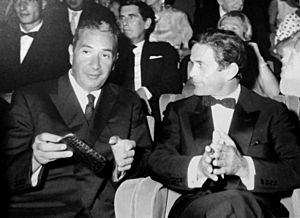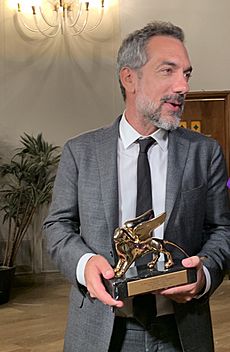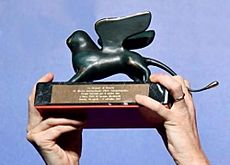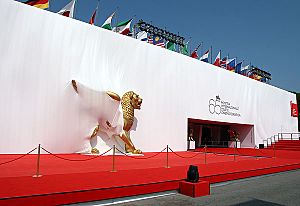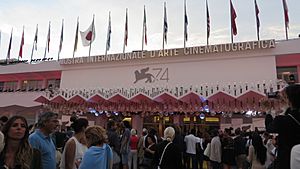Venice Film Festival facts for kids
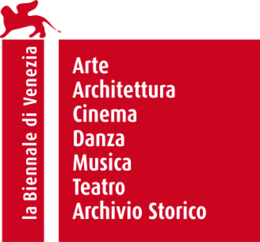 |
|
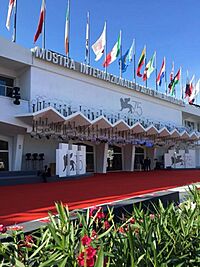
[[Palazzo del Cinema di Venezia|]] on the Lido in 2018
|
|
| Location | Venice, Italy |
|---|---|
| Founded | 6 August 1932 |
| Awards |
|
| Artistic director | Alberto Barbera (since 2011) |
The Venice Film Festival is a super exciting event held every year in Venice, Italy. It's the oldest film festival in the world! Think of it as one of the "Big Five" major film festivals globally. These include the famous ones in Cannes (France) and Berlin (Germany), plus the Toronto International Film Festival in Canada and the Sundance Film Festival in the United States.
This festival is part of something even bigger called the Venice Biennale. The Biennale is one of the oldest art exhibitions in the world, started way back in 1893. It showcases all kinds of art, like painting, dance, music, theater, and architecture. The film festival is probably the most famous part of it all!
The Venice Film Festival usually happens in late August and early September. It takes place on the Lido island, which is in the beautiful Venice Lagoon. During the festival, Venice comes alive with parties, interviews with filmmakers and actors, and screenings that go on all night. The main movies are shown at the historic Palazzo del Cinema.
Many movies that premiere here go on to win big awards, like the Oscars! The 82nd Venice International Film Festival is happening from August 27 to September 6, 2025.
Contents
A Look Back: Festival History
How It All Began
In the 1930s, people in Italy loved movies! Most of the films they watched were American. So, some leaders wanted to create a festival to celebrate Italian culture and films. That's how the Venice International Film Festival started in 1932.
It was created by Giuseppe Volpi, along with Luciano de Feo and Antonio Maraini. Volpi was a powerful businessman who also led the Venice Biennale.
The very first festival opened on August 6, 1932. They showed the American film Dr. Jekyll and Mr. Hyde on a hotel terrace. Nine countries took part in this first event.
Early Years and Awards
No official awards were given at the first festival. Instead, the audience voted for their favorite films and actors. The French movie À Nous la Liberté was voted the funniest film. The Sin of Madelon Claudet was chosen as the most moving film, and its star, Helen Hayes, was named best actress.
The festival didn't happen in 1933, but it returned in 1934 and became an annual event. More countries joined, and they started giving out official awards. These included the Mussolini Cup for Best Italian Film and Best Foreign Film.
In 1935, Ottavio Croze became the first artistic director. A jury was added in 1936 to help decide the winners. The festival also got its own special rules, separate from the main Venice Biennale.
The festival found its permanent home in 1937. The Palazzo del Cinema was built on the Lido. This building has hosted almost every festival since then.
Challenges and Changes
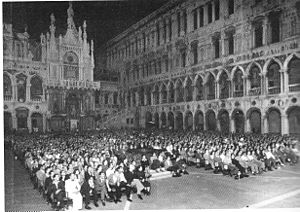
The 1940s were a tough time for the festival because of World War II. Some festivals during this period are not officially counted. For example, the 1940, 1941, and 1942 festivals were held outside Venice. The festival was even called the Italian-German Film Festival for a while. It stopped completely in 1942 due to the war.
The festival came back strong in 1946 after the war ended. It was held in September for the first time. Venice quickly became a major place for films again.
In 1947, the festival was held in the amazing courtyard of the Doge's Palace. A record 90,000 people attended that year! Many people think the 1947 festival was one of the best ever.
A New Era for the Festival
In the 1960s, the festival director, Luigi Chiarini, wanted to make big changes. He focused on showing high-quality artistic films, even if they weren't the most commercial ones.
However, from 1969 to 1979, the festival went through a difficult period. No prizes were given out, and the festival didn't even happen in 1973, 1977, and 1978. The famous Golden Lion award didn't return until 1980.
The Festival's Comeback
The festival started to shine again in 1979, thanks to the new director, Carlo Lizzani. He worked hard to bring back its international fame. He created a team of experts to help choose films and bring in more diverse movies.
In 2004, a new independent film festival called Giornate degli Autori was created alongside the main festival.
To celebrate its 70th birthday in 2013, the festival created a special section called "Venezia 70 – Future Reloaded."
Under the current director, Alberto Barbera, the festival has become a major place for movies hoping to win Oscars. Many Oscar-winning films have had their first showings here, like Gravity (2013), Birdman (2014), Spotlight (2015), La La Land (2016), The Shape of Water (2017), A Star Is Born (2018), The Favourite (2018), Roma (2018), Joker (2019), Nomadland (2020), Dune (2021), The Whale (2022), Poor Things (2023) and The Brutalist (2024).
In 2017, the festival added a new section for virtual reality films. It was first called Venice Virtual Reality and is now known as Venice Immersive. Venice was the first of the "Big Five" festivals to include virtual reality, making it a very important place for this new type of filmmaking.
In 2018, Roma won the Golden Lion. It was the first movie from a streaming service (Netflix) to win a top award at a major film festival.
Festival Leadership
The president of the Venice Biennale represents the festival. This person is chosen by the Italian Ministry of Culture every four years. The current president is Pietrangelo Buttafuoco, who started in March 2024.
The festival director is in charge of organizing all the events. The current director, Alberto Barbera, was appointed in 2011. His term was extended until 2026. He also held the position from 1998 to 2002.
What's in the Festival Programme?
The Venice Film Festival aims to "promote international cinema in all its forms." It wants to share movies as art, entertainment, and an industry, encouraging freedom and discussion. The festival has different sections:
- Official Selection - This is the main part of the festival.
- In Competition - About 21 films compete for the top prize, the Golden Lion.
- Out of Competition - Up to 18 important films are shown but don't compete for awards.
- Orizzonti - This section shows the newest trends in international cinema, often by new and exciting filmmakers.
- Venice Classics - Here, you can see beautifully restored classic films.
- Sconfini - This section features up to 10 unique works, like art house films, experimental movies, TV series, and cross-media projects.
- Venice Immersive - Up to 30 virtual reality works are shown, both in and out of competition.
- Independent and Parallel Sections - These programs explore other interesting parts of cinema.
- International Critics' Week - No more than 8 first-time films are shown here.
- Giornate degli Autori - Up to 12 films are promoted by Italian film director associations.
Awards and Prizes
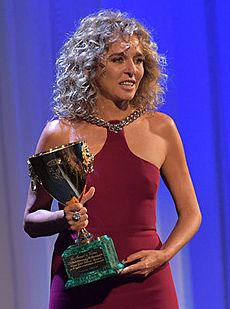

The Venice Film Festival has four juries that decide the winners: Venezia 79, Orizzonti, Premio Venezia Opera Prima “Luigi De Laurentiis”, and Venice Immersive. Here are some of the main awards:
Official Selection: In Competition
- Golden Lion (Leone d'Oro): This is the highest award, given to the best film in the competition. It started in 1949.
- Grand Jury Prize: Awarded to the second-best film.
- Silver Lion (Leone d'Argento): Given to the best director.
- Special Jury Prize: Awarded to the third-best film.
- Volpi Cup (Coppa Volpi): Given to the best actor and best actress.
- See – Volpi Cup for Best Actor
- See – Volpi Cup for Best Actress
- Best Screenplay: For the best movie script.
- Golden Osella (Osella d'Oro): For amazing creative or technical work in a film.
- Marcello Mastroianni Award: Started in 1998, this award celebrates a talented new actor or actress.
- Special Lion: Given to a director or actor for their overall work in a film shown in the main competition.
Orizzonti (Horizons)
This section looks for new and exciting ways of telling stories in film. It has several awards:
- The Orizzonti Award for Feature Films
- The Special Orizzonti Jury Prize (for feature films)
- The Orizzonti Award for Short Film
- The Orizzonti Award for Medium-length Film
More awards were added later:
- The Orizzonti Award for Best Director
- The Orizzonti Award for Best Actor
- The Orizzonti Award for Best Actress
- The Orizzonti Award for Best Screenplay
Venice Immersive
This section is all about Extended Reality (XR) and virtual reality films. It's dedicated to new ways of experiencing stories. The awards in this section are:
- Venice Immersive Grand Prize
- Venice Immersive Special Jury Prize
- Venice Immersive Achievement Prize
Giornate degli Autori
The Giornate degli Autori (also known as Venice Days) is an independent section that started in 2004. It's like a special showcase for films chosen by Italian film director groups. Awards here include:
- Giornate Degli Autori (GDA) Award
- Label Europa Cinema Award
- BNP Paribas People's Choice Award
Lion of the Future (Luigi De Laurentis)
This award is for the best first-time feature film shown at the festival. The winner gets $100,000, split between the director and the producer.
Glory to the Filmmaker Award
The Glory to the Filmmaker Award celebrates people who have made a huge impact on modern cinema. It's given in partnership with luxury brands like Cartier.
Past Awards
Mussolini Cup
The Mussolini Cup was the top award from 1934 to 1942 for Best Italian and Best Foreign Film. It was named after Italy's leader at the time. This award was stopped in 1943.
Mussolini Cup for Best Italian film
| Year | Film | Original title | Director(s) |
|---|---|---|---|
| 1934 | Loyalty of Love | Teresa Confalonieri | Guido Brignone |
| 1935 | Casta Diva | Carmine Gallone | |
| 1936 | Lo squadrone bianco | Augusto Genina | |
| 1937 | Scipio Africanus: The Defeat of Hannibal | Scipione l'africano | Carmine Gallone |
| 1938 | Luciano Serra, Pilot | Luciano Serra pilota | Goffredo Alessandrini |
| 1939 | Cardinal Messias | Abuna Messias | Goffredo Alessandrini |
| 1940 | The Siege of the Alcazar | L'assedio dell'Alcazar | Augusto Genina |
| 1941 | The Iron Crown | La corona di ferro | Alessandro Blasetti |
| 1942 | Bengasi | Augusto Genina | |
Mussolini Cup for Best foreign film
| Year | Film | Original title | Director(s) | Country |
|---|---|---|---|---|
| 1934 | Man of Aran | Robert J. Flaherty | United Kingdom, Irish Free State | |
| 1935 | Anna Karenina | Clarence Brown | United States | |
| 1936 | Der Kaiser von Kalifornien | Luis Trenker | Nazi Germany | |
| 1937 | Life Dances On | Un carnet de bal | Julien Duvivier | France |
| 1938 | Olympia | Leni Riefenstahl | Nazi Germany | |
| 1940 | Der Postmeister | Gustav Ucicky | ||
| 1941 | Ohm Krüger | Hans Steinhoff | ||
| 1942 | The Great King | Der große König | Veit Harlan | |
Great Gold Medals for Entertainment
These medals were given to the Best Actor and Best Actress. Later, they were replaced by the Volpi Cup. The first actress to win this prize was Katharine Hepburn for her role in Little Women.
Audience Referendum
At the very first festival in 1932, there was no jury. Instead, the audience voted for their favorites. The "Best Director" was given to Nikolai Ekk for his film Road to Life. The film À Nous la Liberté by René Clair was voted "Best Film."
Award for Best Director
| Year | Director(s) | Film | Original title |
|---|---|---|---|
| 1935 | King Vidor | The Wedding Night | |
| 1936 | Jacques Feyder | Carnival in Flanders | La Kermesse Héroïque |
| 1937 | Robert J. Flaherty and Zoltan Korda | Elephant Boy | |
| 1938 | Carl Froelich | Heimat | |
See also
 In Spanish: Festival Internacional de Cine de Venecia para niños
In Spanish: Festival Internacional de Cine de Venecia para niños
- Venice Biennale
- Rome Film Festival
- Berlin International Film Festival
- Cannes Film Festival
- List of Big Three film festivals winners


